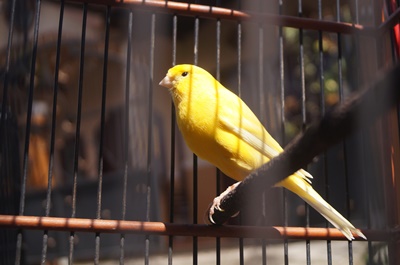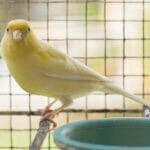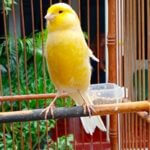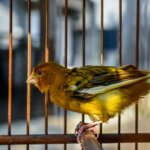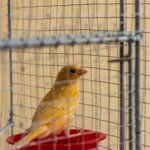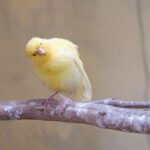Seizures are a surprisingly common concern in canaries. While a seizure isn’t always fatal, especially the first time, you need to understand how to help the canary recover.
Warning signs that a canary will have a seizure include changes in behavior, especially loud vocalizations and hyperactivity, ahead of the limbs seizing up and the canary convulsing and jerking on the ground.
Immediately following a seizure, clear the canary’s cage of all perches and toys and line the bottom with soft blankets and bedding. Ensure the canary has access to water and soft food and is warm enough.
Even if the canary seems okay after a seizure, ask an avian vet to run tests. Seizures are a symptom of a wider health concern, so this needs to be evaluated to prevent seizures from recurring.
Can Canaries Have Seizures?
A seizure is a direct consequence of electrical discharge from the canary’s brain, which impacts the nervous system, resulting in involuntary spasms, behavioral changes, and loss of control.
When most people think of seizures, they picture convulsing, spasming, and losing consciousness. While this is certainly a prominent part of the seizure process, it’s just one phase of three and only lasts for around 30 seconds.
When a canary has a seizure, the whole experience lasts up to two hours before it concludes. While it’s likely that the canary will return to normal after the event, don’t shrug off a seizure as a one-off event.
If a canary has a seizure once, it will likely do so again.
Why Do Canaries Have Seizures?
There are many possible triggers for seizures in canaries. The most common include:
- Traumatic head injuries include flying into a wall, closed window, or another solid object.
- Substandard diet and nutrition, including hypocalcemia (low calcium), hyperglycemia (low blood sugar), dehydration, or a lack of essential vitamins.
- A stressful living environment potentially causes hypertension (high blood pressure).
- Viral or bacterial infection is caused by unsanitary living conditions or contagious diseases passed between birds or shared by owners.
- A fungal infection that attacks the spinal cord or cognitive function.
- Ingestion or inhalation of toxins, such as paint fumes, household cleaning materials, or air fresheners.
- Poor temperature and lighting conditions, especially a lack of natural sunlight or excessive heat.
- Disease or failure of the internal organs caused by unidentified long-term sickness, including brain tumors or epilepsy.
In some rare cases, seizures can also be caused by an inherited medical condition. If adopting a canary from a third party, learn about its heritage, including health conditions suffered by parents.
What Does a Seizure Look Like?
Common signs of seizures in canaries include:
- Sudden, inexplicable changes in behavior and demeanor.
- Hyperactivity.
- Loud vocalizations.
- Twitching and convulsing.
- Inability to hold onto a perch.
- Loss of consciousness.
Once the seizure happens, it’ll unfold over three stages:
| Preictal | The canary may be more active than usual, flapping its wings and hopping or flying around, starting to vocalize loudly and display uncharacteristic aggression. |
| Ictal | This is the seizure itself. The canary will stiffen and lose control of its muscles, bladder, and bowel. The canary will fall to the cage floor and convulse, usually for around 30 seconds, and it may lose consciousness. |
| Postictal | After the twitching and convulsing, the scary part of the seizure is over. It’ll be an hour or two before your canary fully recovers. Expect the bird to be irritable, confused, and sleepy. |
Once the postictal phase concludes, the canary’s behavior may return to normal.
The canary will act as though nothing happened. While you mustn’t frighten or unsettle the canary by fussing over it, don’t shrug off the seizure as a non-event.
Can Canaries Die from Seizures?
A seizure is a symptom of a wider problem, not an illness in and of itself. However, a seizure can still be fatal for a canary. The reasons a seizure could kill a canary include the following:
- Falling during a seizure leads to a traumatic brain injury.
- Severe convulsions lead to a broken neck or another irrevocable injury.
- Stress caused by the seizure places excess pressure on the canary’s heart.
- Permanent brain damage due to a prolonged seizure.
It’s rare for a single seizure to be fatal for a canary unless the canary is particularly unlucky and experiences one of these mishaps. Seizures aren’t just something that happens without reason, though.
If a canary has a seizure, the underlying cause is a greater risk to its long-term health. If the seizure was from toxicity, for example, the danger has not passed, and issues with diet will not be resolved.
During and after the event, focus on getting the canary safe and comfortable. In the aftermath, learn what caused the concern and take the necessary action to prevent a repeat.
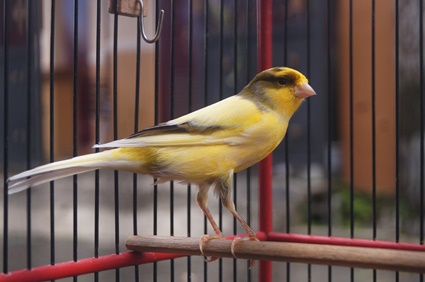
Treatment for Seizures in Canaries
If the canary is undergoing a seizure, you’ll need to care for it during the process. Follow these steps to keep the canary safe during an active seizure:
- Stand back and don’t approach the canary during the preictal or ictal phases unless its life is in danger due to the surroundings.
- Dim the lights in the room.
- During the postictal phase, line the bottom of the cage with soft blankets.
- Remove everything from the cage except food and water – no perches, toys, or other distractions.
- Ensure the canary can easily access food and water dishes without moving far.
- Keep the environment quiet and calm, with minimal noise. Ensure the canary is warm, but don’t risk overheating.
- Observe the canary, watching for any ill effects after the seizure, but don’t attempt to handle it.
Until the seizure completely passes, focus on keeping the canary safe.
What Helps a Canary After a Seizure?
After a seizure, a canary may seemingly return to normal. It may be that the canary will never experience a seizure again, but it’s more likely that this will become a recurrent experience.
Make the canary as comfortable as possible, then arrange an appointment with a vet to check the canary to determine the cause of the seizure and manage a potential recurrence.
The Journal of Exotic Pet Medicine explains that a seizure in which the ictal phase lasts five minutes or more is a medical emergency. This will be referred to as status epilepticus.
Diagnosis
Your vet will run a range of tests on the canary to determine the cause of the seizure.
A vet’s tests include blood tests, scans, and radiographs. Blood tests will reveal any problems with the internal organs, such as underperforming liver or renal failure. Blood can also reveal a potential disease.
Radiographs will determine potential toxins. Scans to be brain will also be vital, as these will reveal any cranial trauma or damage or a long-term issue with the brain, such as epilepsy, tumors, or growths.
It’s risky, but some vets also run tests that potentially trigger seizures. Trends in Neurosciences stated that a reflex could cause some seizures to external stimulation, such as bright or flashing lights.
In some cases, a vet can’t identify the cause. In these instances, the diagnosis will be “idiopathic epilepsy.”
Treatment
The canary may involve medication, lifestyle adjustments, or surgery.
If the seizure was caused by toxicity, this would be flushed out of the body using fluids or chelating drugs. Dietary deficiencies or dehydration can be resolved by introducing intravenous fluids or supplements.
Bacterial infections will be resolved through antibiotic drugs, usually taken over a prolonged period on an outpatient basis. Ongoing issues like hypertension will also need to be resolved on an ongoing basis, alongside lifestyle changes.
In some cases, a canary may be prescribed with anticonvulsant drugs. This will be reserved for birds experiencing regular seizures, where further testing is necessary.
A canary can’t take anticonvulsants for life, so the problem must be resolved.
Recovery
Once the canary has been discharged from a vet following a seizure, you’ll be advised how to proceed. You’ll likely be given a diet plan alongside lifestyle changes to reduce the possibility of recurring seizures.
In most cases, you’ll be advised to keep the canary as calm as possible.
This may involve changing the room of the canary’s cage, ensuring it gets enough sleep, isn’t subjected to too much artificial light or excitement, and enjoys a reliable routine.
Monitor a canary for signs of a seizure, especially if a direct cause hasn’t been identified. Once you have established a relationship with a reliable vet, take the canary for check-ups.

